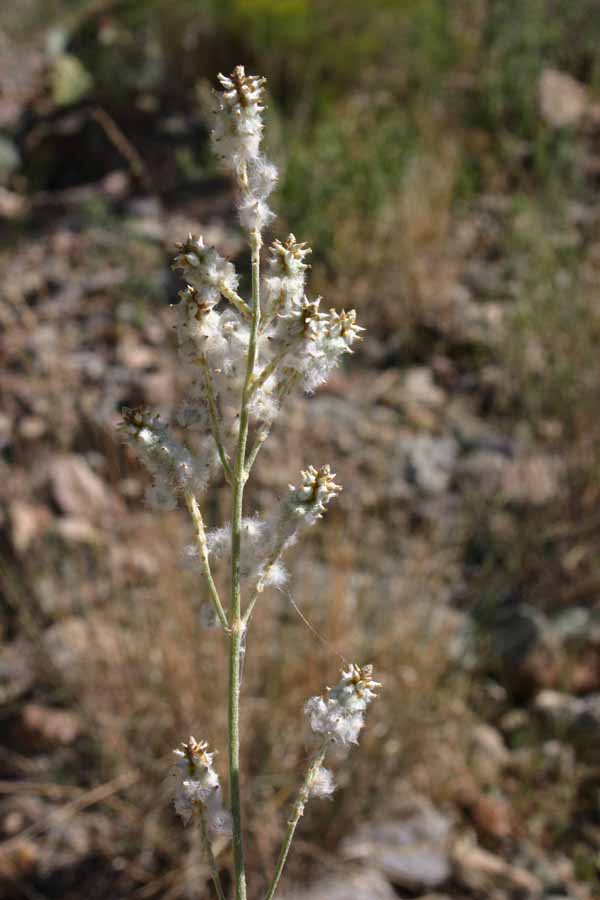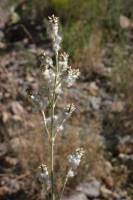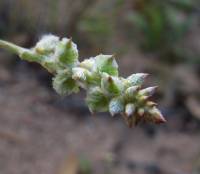Herbs [shrubs], annual or perennial. Stems erect or procumbent, simple to much-branched, sometimes broomlike, usually richly pubescent. Leaves opposite, sessile or short-petiolate, most abundant on proximal 1/2 of plant; blade linear, lanceolate, oblanceolate, oblong, or orbiculate, fulvous abaxially, margins entire, usually pubescent. Inflorescences terminal, erect, pedunculate, spiciform, mostly compound, usually elongate and interrupted, or rounded and headlike; rachis consisting of spirally arranged bracts that adaxially subtend 2 concave imbricate bracteoles enclosing and falling with the flowers, silky or woolly. Flowers bisexual; tepals 5, connate at least to middle into tube; lobes lanceolate to acute; tube 2-lipped, 5-lobed, surpassing bracteoles, lanate, becoming indurate in fruit and developing lateral wings or crests and, in some species, facial tubercles or spines; stamens 5; filaments connate into cylindric to flask-shaped, 5-lobed tube, lobes (pseudostaminodes) with margins entire or shallowly notched, apex blunt to acute; anthers attached at sinuses, 2-locular; ovule 1; style 1, short or elongate, shorter than staminal tube; stigmas sessile, minutely 2-fid to capitate or penicillate. Utricles enclosed by indurate perianth tube, ovoid or flask-shaped, membranaceous, indehiscent. Seeds 1, obovoid or lenticular, germinating while enclosed by perianth tube. x = 8.
Froelichia is most abundant in the Sonoran and Chihuahuan deserts, the plains of southern Texas and Florida in North America, and the grasslands of South America, particularly eastern Paraguay and southern Brazil. Two species (F. lanigera Andersson, F. nudicaulis Hooker f.) are endemic to the Galápagos Islands.
Froelichia is divided into sect. Hoplotheca (Nuttall) Moquin-Tandon, with stigmas interpreted as being capitate (the capitate form is derived from a bifid structure), and sect. Dilopha Moquin-Tandon, with penicillate stigmas. Section Dilopha is restricted to South America; sect. Hoplotheca to North America and South America.
Evolutionarily there are two principle clades occuring across North America. One clade comprises the perennial Froelichia interrupta comprised of three varieties occuring south through most of Mexico to Nicaragua. Morphologically the group is distinguished by plants with relatively sparsely flowered inflorescences with the flowers arranged in a 3-ranked spriral. The pseudostaminodes are short and exhibit a blunt apex. The second clade occurs to the north and comprises a mix of annual and perennial species, including the taxa described here and F. 'xantusii' R. A. McCauley, which is endemic to southern Baja California.
Froelichia is probably best known as a roadside weed because it thrives in occasionally disturbed environments with little competition. It is also a common member of coastal pine areas, particularly along the Gulf Coast. The plants are pioneers in disturbed sandy soils, can become agricultural pests in rare instances, and form large patches in fallow fields or pastures. Introduction of Froelichia has occurred throughout much of the United States (F. gracilis); F. floridana is naturalized in Queensland, Australia, most likely from contaminated seed in the mid-1950s.
Confusion in the identity of Froelichia species has been due in large part to the over-reliance on variable characters, principally the nature of the lateral wings on the mature perianth. Recent revisionary work (R. A. McCauley 2002) has served to identify more stable characters for identification and has led to recircumscriptions of the geographic ranges of the species.
Fls perfect, each subtended by a scarious bract and 2 bractlets; cal tubular, becoming flask-shaped or conic and indurate in fr, shortly 5-lobed, densely woolly; stamens 5, the filaments united into a tube equaling the cal and suggesting a sympetalous cor, the 5 oblong, bisporangiate and unilocular anthers alternating with 5 ligulate lobes; style slender; stigma capitate; ovule 1; fr a membranous, indehiscent utricle, included in the indurated cal-tube; ours annuals with narrow, opposite lvs and woolly terminal spikes. 20, New World.
Gleason, Henry A. & Cronquist, Arthur J. 1991. Manual of vascular plants of northeastern United States and adjacent Canada. lxxv + 910 pp.
©The New York Botanical Garden. All rights reserved. Used by permission.







